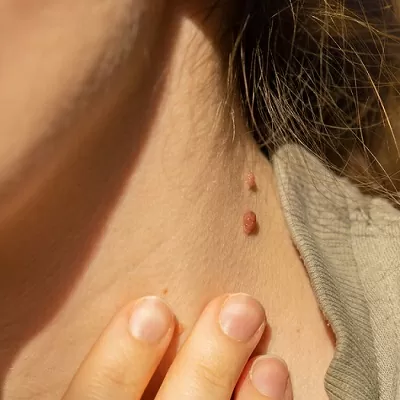Can I remove a skin tag myself?

Skin tags, also known as acrochordons, are common, benign growths that can develop anywhere on the body, especially in areas where skin rubs against skin or clothing. These small, soft growths are typically harmless, but many people seek ways to remove them for cosmetic reasons. The question often arises: “Can I remove a skin tag myself?” While some may be tempted to take matters into their own hands, it’s important to understand the risks and the safest options available for skin tag removal in Dubai.
What Are Skin Tags?
Skin tags are small, benign growths that are usually flesh-colored or slightly darker. They are made up of skin cells, collagen fibers, and blood vessels. While skin tags can appear anywhere, they are most commonly found on the neck, armpits, eyelids, under the breasts, or in the groin area. They vary in size and may be as small as a grain of rice or as large as a pea.
Why You Shouldn’t Remove a Skin Tag Yourself?
While removing a skin tag at home might seem like an easy fix, there are several reasons why it’s better to consult a professional. Some of these include:
- Infection Risk: Using unclean tools or improper techniques can introduce bacteria, leading to infection. A professional will ensure that the area is properly sterilized to reduce this risk.
- Misdiagnosis: Skin tags may resemble other types of growths, such as moles or warts. Attempting to remove a skin tag without proper evaluation could result in the removal of something that requires a different form of treatment.
- Scarring: Improper removal can lead to permanent scarring, which can sometimes be worse than the appearance of the skin tag itself.
- Pain and Discomfort: Without the proper techniques or numbing agents, attempting to remove a skin tag at home can be painful and uncomfortable. A dermatologist can perform the procedure with minimal pain and aftercare guidance.
- Regrowth: In some cases, a skin tag might regrow after being improperly removed, meaning you may end up needing a professional treatment anyway.
Safe Professional Methods for Skin Tag Removal
If you’ve decided that professional treatment is the best course of action, there are several methods that dermatologists commonly use to remove skin tags. These treatments are safe, effective, and minimally invasive:
- Cryotherapy: This technique involves freezing the skin tag with liquid nitrogen. The freezing process destroys the tissue, causing the skin tag to fall off after a few days or weeks.
- Excision: In this method, a dermatologist will use a sterile scalpel to cut off the skin tag. This procedure is typically quick and can be done under local anesthesia to minimize discomfort.
- Cauterization: Cauterization uses heat to burn off the skin tag. This method helps stop bleeding by sealing blood vessels while removing the growth.
- Ligation: This technique involves tying off the skin tag with a small thread or string to cut off its blood supply. Over time, the skin tag will fall off on its own.
Each of these methods is performed under the guidance of a professional who ensures the procedure is done safely and effectively. The choice of method depends on the size and location of the skin tag and the patient’s preferences.
Why Opt for Professional Skin Tag Removal?
There are several reasons why you should leave skin tag removal to the professionals, especially in places like Skin Tag Removal in Dubai:
- Safety: Professional clinics ensure sterile environments and use FDA-approved treatments.
- Precision: A trained professional can remove the skin tag without harming surrounding tissues.
- Less Risk of Scarring: Proper technique minimizes the chance of scarring or further skin damage.
FAQ:
- Can skin tags come back after removal?
- In most cases, once a skin tag is properly removed, it does not grow back. However, new skin tags may develop in different areas due to ongoing friction or genetic factors.
- Are skin tags harmful?
- No, skin tags are benign and do not pose any health risks. However, if a skin tag becomes painful, inflamed, or shows signs of infection, it’s important to consult a healthcare provider.
- Is skin tag removal covered by insurance?
- Cosmetic skin tag removal is generally not covered by insurance, as it is considered a non-medical procedure. However, if a skin tag is causing significant irritation or pain, insurance may cover the removal.
- Can skin tags be removed without leaving a scar?
- Professional skin tag removal is often done in a way that minimizes scarring. However, some scarring may occur, depending on the method used and the individual’s healing process.
Conclusion
While it may be tempting to attempt skin tag removal at home, it is far safer and more effective to seek professional treatment. DIY removal carries risks of infection, scarring, and misdiagnosis. A qualified dermatologist or cosmetic surgeon can remove skin tags safely, ensuring the process is smooth and free of complications. If you’re considering skin tag removal in Dubai, consult with a professional to discuss the best options tailored to your needs. Choosing a medical professional over at-home remedies will ensure that your skin tag removal is as safe and effective as possible.



